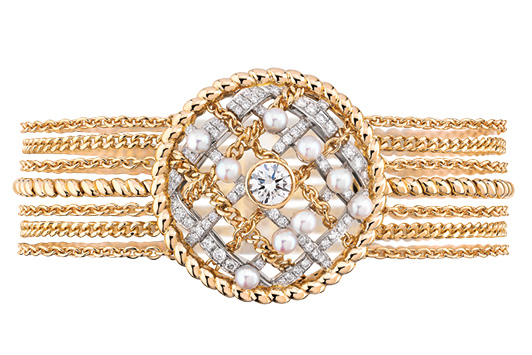
Most maisons unveil their high-jewelry collections during Paris Haute Couture Week in July. However, some have taken to introducing themed “signature” lines at January’s haute couture shows, such as Chanel’s tribute to tweed this year, and Boucheron’s Question Mark necklaces. What is clear from the January 2020 offerings is that maisons are taking the opportunity to experiment, whether it’s with gem cuts, juxtapositions of color, or even a new design direction. Here’s a look at the high-jewelry trends from some of the major houses.
Boucheron
Boucheron creative director Claire Choisne has chosen the flamboyant Art Nouveau-style Question Mark necklace as the first subject of an annual signature collection the jeweler will reveal each January. Frédéric Boucheron originally designed the Question Mark in 1879.
The opulent, open-ended design wrapped around the neck and finished in a flourish of diamonds deep into the décolletage, although there are other ways of wearing it. Actress Salma Hayek, for instance, wore a diamond and pearl Question Mark wrapped around an extravagant bun in her hair at this year’s Academy Awards.
Choisne has created eight modern interpretations of the iconic design, including the tremblant ivy leaf Lierre de Paris design with emerald pavé, the diamond and Burmese sapphire Plume de Paon, and the baroque Feuilles d’Acanthe in yellow gold and diamonds.
“The Boucheron style is above all a state of mind,” the creative director says. “In my opinion, it is captured perfectly by the Question Mark necklace, which I wanted to reinstate as one of Boucheron’s main signature pieces as soon as I arrived at the maison.” The necklace encapsulates the jewelry house’s “ethos of innovation, with a focus on emotion, and the beauty of expression, with a focus on women’s freedom,” she adds.
Dior
Victoire de Castellane’s new
Dior et Moi collection is a play on the popular “toi et moi” dual-gem design frequently used for rings, but the novelty here is the way she mixes exceptional and semi-precious stones to create eye-catching symbiotic relationships.
As creative director for jewelry, de Castellane is a colorist. On one double ring, she uses a cabochon turquoise and faceted emerald to pick out the colors of a black opal she’s set beside them. And for one of her between-the-finger rings, she frames a central black opal with a rainbow halo of gems and then adds a pink sapphire and a pearl as satellites. The effect is strikingly modern.
Opals are a favorite of the designer and so feature strongly in this 39-piece collection, some with lacquer settings highlighting their iridescent colors. Lacquer has been a signature of the maison since 2006, and Dior approaches it in the same way it does precious materials. It uses 15 shades of lacquer, in either solid or graduating tones, to make the gems’ colors pop.
Another modern touch is the use of asymmetric designs — especially for the earrings, which mix geometric gemstone cuts with soft, rounded semi-precious stones. One pair features a lacquer-framed opal and blue sapphire on one earring, and a lapis lazuli teardrop above a sapphire-framed pearl on the other; it’s the blue tones that marry them together.
Louis Vuitton: rough plans
Not every brand can say it’s planning to incorporate the world’s second-largest rough diamond into its jewelry. In January,
Louis Vuitton announced its 50% investment in the Sewelo diamond from Lucara’s Karowe mine and showcased the 1,758-carat rough at its Place Vendôme store.
The potential of the stone, which is covered in carbon, will become clearer over the coming months as Antwerp-based manufacturer HB Company makes progress in cutting it. However, Louis Vuitton has ambitions for using some of the resulting polished in its 2021 high-jewelry collection, which is less than 18 months away. One can only wonder what delights are locked inside this diamond.
Chanel
From the Scottish borders to the couture house on the Rue Cambon, and now the workshops of Place Vendôme,
Chanel’s devotion to tweed opens a new chapter in high jewelry. The camellia, the lion, and motifs from the Coromandel screens in Gabrielle “Coco” Chanel’s apartment are all signatures the company has reproduced in jewelry. However, mimicking the suppleness of a handwoven fabric in gold and gemstones is quite another achievement.
During her love affair with the duke of Westminster in the 1920s, Chanel acquired a taste for wearing tweed on his Highland estate. She saw opportunities for adapting the masculine cloth for womenswear, and it became a staple of her haute couture.
Not one to shy away from a challenge, the brand’s high-jewelry workshop has developed special articulation techniques to give its jewels the texture and flexibility of fabric, creating pieces that intertwine precious metal and gemstones on several planes. On its necklaces, cuffs and earrings, Chanel has used strings of pearls, diamonds and sapphires for the warp, and fine gold chains for the weft. Some designs weave a combination of gold chains together, while little diamond and pearl button earrings replicate the tweed buttons that one would find on a couture suit.
Image: ChanelArticle from the Rapaport Magazine - April 2020. To subscribe click here.